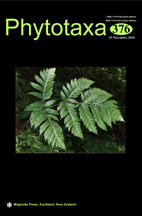Abstract
The evolutionary history of the dracaenoid genera Dracaena and Sansevieria (Asparagaceae, Nolinoideae) remains poorly resolved, despite long-recognised issues with their generic boundaries and increased attention paid by both horticulturalists and taxonomists. In this study we aim to: (1) elucidate evolutionary relationships within and between Dracaena and Sansevieria using molecular phylogenetic inference of both nuclear (nDNA) and plastid (cpDNA) markers, (2) examine the infrageneric classifications of each genus, and (3) revise the circumscription of the dracaenoids in light of morphological and phylogenetic evidence. In total, we sampled 21 accessions of Dracaena (ca. 19 species), 27 accessions of Sansevieria (ca. 26 species), and six outgroup taxa. Phylogenetic analyses were based on nucleotide sequences of two non-coding plastid DNA regions, the trnL-F region (trnL intron and trnL-trnF intergenic spacer) and rps16 intron, and the low-copy nuclear region At103. Phylogenetic hypotheses were constructed using maximum parsimony, maximum likelihood, and Bayesian inference. Individual datasets were analysed separately and, after testing for congruence, as combined datasets. We recovered instances of soft incongruence between nDNA and cpDNA datasets in Sansevieria, but general trends in the dracaenoids were congruent, although often poorly supported or resolved. The dracaenoids constitute a strongly supported monophyletic group. Dracaena was resolved as a paraphyletic grade embedded with two clades of Sansevieria, a primary clade comprising most species, and a secondary clade including S. sambiranensis, a distinctive species from Madagascar. The backbone of our phylogeny was only resolved in nDNA analyses, but combined analyses recovered strongly supported species groups. None of the previous infrageneric classifications were supported by our phylogeny, and biogeographic groupings were frequently more significant than morphology. More work is needed to resolve internal relationships in the dracaenoids, but we support a recent proposal to recognise a broadened circumscription of Dracaena that includes Sansevieria. We provide a generic description for the recircumscribed Dracaena and new combinations for several species of Sansevieria in Dracaena.

